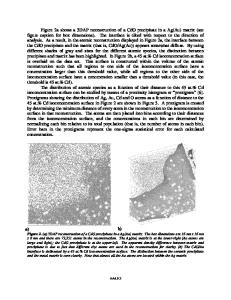Solute-Atom Segregation at Internal Interfaces
- PDF / 1,343,017 Bytes
- 7 Pages / 604.8 x 806.4 pts Page_size
- 48 Downloads / 370 Views
MBER1990
the results are compared with expérimental atom-probe field-ion-microscopy results. Finally, the results of an atomprobe study of t w o - d i m e n s i o n a l Re ségrégation at a twist boundary with a small tilt component in a W-Re alloy are presented. Computational Approach Calculation of the equilibrium structure and composition of interfaces is a two-part problem. First, a model for the energetics of the interface as a function
of the location and chemical identity of the constituent atoms is d e v e l o p e d . This model must hâve sufficient computational speed so that the energetics of numerous configurations can be evaluated. The approach we will pursue hère is the embedded atom method (EAM) developed by Daw and Baskes. 3 The second part of the problem is to solve the statistical mechanical problem of the compositional equilibrium between the bulk and the interfacial région. This second aspect is addressed using Monte Carlo computer simulation techniques. EAM is a semi-empirical technique for Computing the total energy of an arbitrary arrangement of atoms. 3 The computational effort involved in this approach is comparable to that of pair interaction models, but the EAM includes certain many-body interactions that dépend on the local environment of an atom. It has been used successfully for a wide range of problems involving metals and alloys; this approach has been described in a previous article in the MRS BULLETIN.4 Currently, there exist potentials appropriate for the study of alloys composed of the six fcc metals in the Cu and Ni columns. 3 The statistical mechanics are deter-
CHEVRON DETECTOR (a) ^
m
m
m
m
^
M
4
IMAGE INTENSI FICATION SYSTEM PROBE HOLE SOLUTE ATOMS GRAIN BOUNDARIES
CYLINDER OF ALLOY ANALYZED Figure 1. Schematic diagram illustrâtes the two basic géométrie configurations for analyzing a grain boundary by the APFIM technique. The distance between the Chevron detector and the tip is —2200 mm, while the distance from the tip to the image intensification System is variable and is typically 40 mm. The diameter of the probed région, D„, is a variable quantity that dépends on the local radius of the tip, and the distance from this région to the image intensification System.
51
Solute-Atom Ségrégation at Internai Interfaces
mined using atomistic Monte Carlo simulations.5 Thèse simulations consider the position and chemical species of each atom and are performed via the Metropolis algorithm. Two types of steps are included in thèse simulations. First, each atom is allowed to be displaced from its current position. Second, the chemical species of each atom can be changed. (In the simulations, the chemical potential différence between the two éléments is held fixed; the bulk composition is selected by the choice of the chemical potential différence.) This type of simulation has several advantages. First, thermal equilibrium is determined correctly within the limits of the statistical sampling. In addition, the atomic structure of the boundary is allowed to relax so that the s
Data Loading...











